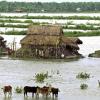

Shared Socioeconomic Pathways Scenario Database (SSP)

Keywan Riahi
Program Director and Principal Research Scholar (ECE); Principal Research Scholar (IACC, PM, S3, TISS)

Volker Krey
Research Group Leader and Principal Research Scholar (IACC); Principal Research Scholar (S3)